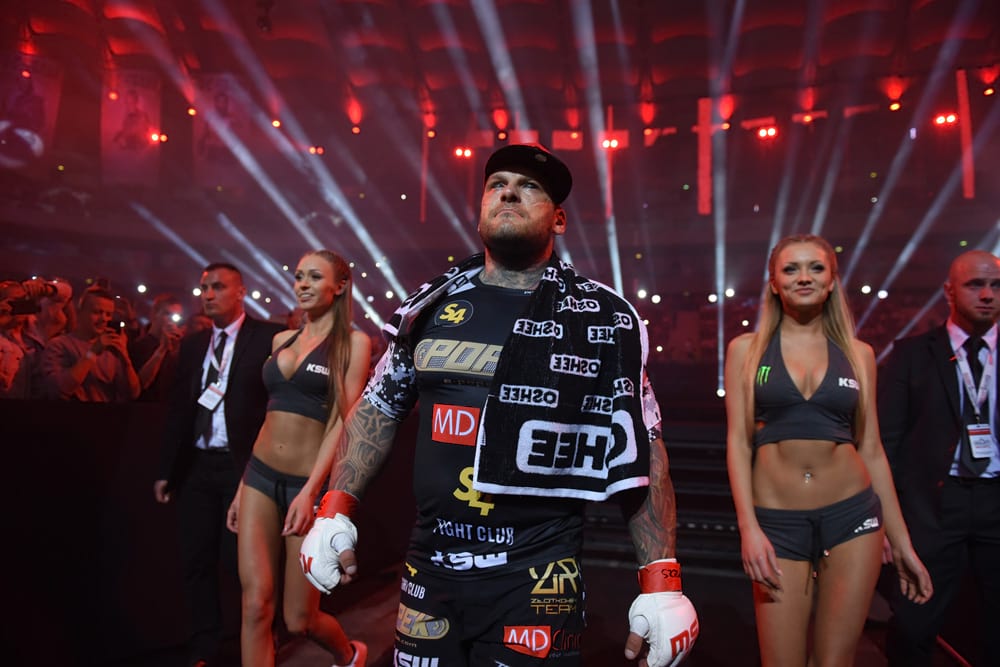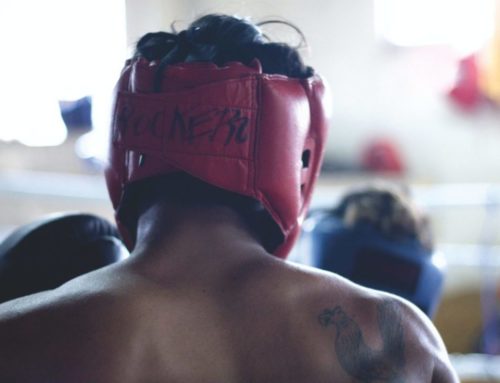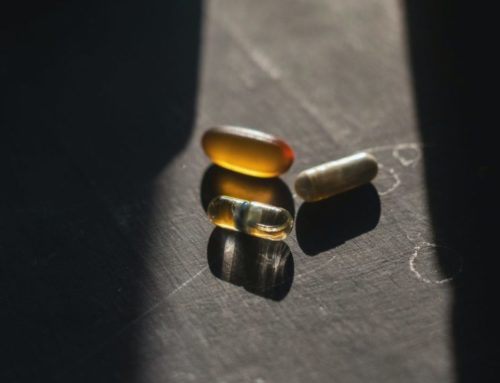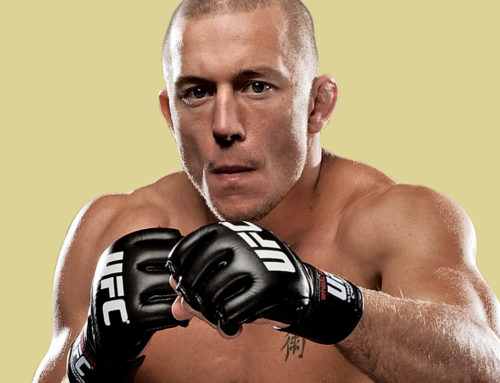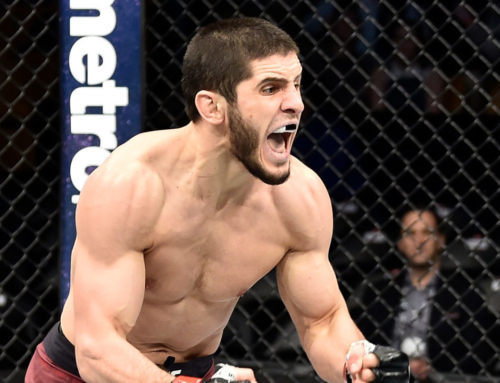As real as it gets was once the UFC’s mission statement, the tagline that revealed why mixed martial arts was different to the others and why it needed to be respected. It was scrawled on T-shirts and posters, it was boasted and yelled in promo videos, and it carried weight at a time when the sport’s very popularity and acceptance hinged on its authenticity.
Yet, to witness KSW 39: Colosseum on May 27 was to witness not only a celebration of Polish MMA – the good, the bad, the ugly – but also something that seemed to directly oppose this ideology. Laughed in its face, in fact. Told it to stop taking itself so seriously. Pulled its oversized shorts down. “This,” said a commentator halfway through the event, “is the element of the show the aficionados refer to as freak.”
That’s not to say the blockbuster event in Poland was unauthentic, nor should it undermine the force and intent of the punches and kicks and submissions divvied out by its participants in eleven fights. But, certainly, what should be made clear from the offset is this: KSW 39 was, in the best way possible, as surreal as it gets. Not only that, it was surreal in a way that no longer looks out of place or even all that bizarre in the wider context of combat sports. Look around. It’s not just KSW. They’re all doing it. In MMA, in boxing, sometimes at the same time, together, as is the case with the mooted money fight between boxer Floyd Mayweather and mixed martial artist Conor McGregor. We are, let’s face it, in an age of super-sized surreality.
That this extends to fight sports – one of the most primal and unpredictable domains in which two human beings can settle a dispute – should come as no surprise. If anything, mixed martial arts has long embraced the extravagant and the controversial and it’s this rich history of show and spectacle which was regurgitated and then spat back at us inside the PGE Narodowy Stadium in Warsaw on May 27. Both a celebration of the past and a flash-forward to a dystopian future, the event set a record (57,766) for most-attended MMA event in Europe, usurped UFC 193 (56,214) in terms of the worldwide rankings – placing it second only to Pride Shockwave in 2002 (71,000) – and left its ambitious promoter, Martin Lewandowski, in need of a break, if not a complete regeneration. “I need to go to a special place where old people go to get their treatment,” he told Fighters Only the week after the event. “A retreat, maybe. I need to recover from this.”
We all did. We all needed to recover, take stock, digest what we had witnessed. An attack of the senses, auditory and visual, watching KSW 39 on a Saturday evening was akin to watching a series of fights spontaneously break out an Olympic Games opening ceremony. A sea of mixed messages, it was on one hand a music concert, replete with rock bands, epic gladiatorial tracks cranked up to eleven over the PA system, a heartfelt tribute to a deceased Polish composer and a man dressed as Friar Tuck nailing a saxophone solo, and on the other hand a fight card so diverse and often otherworldly it could just as well have taken place in the parking lot before a handful of bloodthirsty vagabonds.
There were men, women, big ones, little ones, ones with title hopes, ones with no hope. There were long fights and short fights, real fights and unreal fights. There was a fight between a Satanist and a Christian. There was a fight between a Polish rapper with tattooed eyeballs and a cartoonish Lithuanian weightlifter whose eyeballs, veins and everything else popped, a fight which gave birth to arguably the greatest promo line of all-time: “I think his biggest problem is he eats little sandwiches,” said Robert Burneika, “when my diet consists of hardcore steaks!” There was a fight between Sokoudjou, formerly of the UFC and seemingly every other MMA promotion, and a KSW commentator, Łukasz Jurkowski, who retired from fighting in 2011. There was, of course, Mariusz Pudzianowski. He, a former five-time ‘World’s Strongest Man’, was fighting a fellow strongman who’d grown accustomed to finishing behind him in competitions and was now attempting to gain revenge in the ultimate proving ground (cue dramatic music). There was, in summary, something for everyone; which, I guess, is the point. In putting just shy of 60,000 tickets on sale, it’s the everyone Lewandowski was looking to seduce.
“When the idea of doing the show at the national stadium came about, I knew each fight had to work on a different level,” said the promoter. “You had sport fights and you also had the freak fights. They might go over the heads of the fans, but that’s okay. I knew I could not rely on title fights to sell out the national stadium. I had to have other fights that would attract the other people, the other Poles, those who just want to go and see entertainment. I started with the female title fight. You then had freak fights. You had five title fights. All my major heroes appeared.”
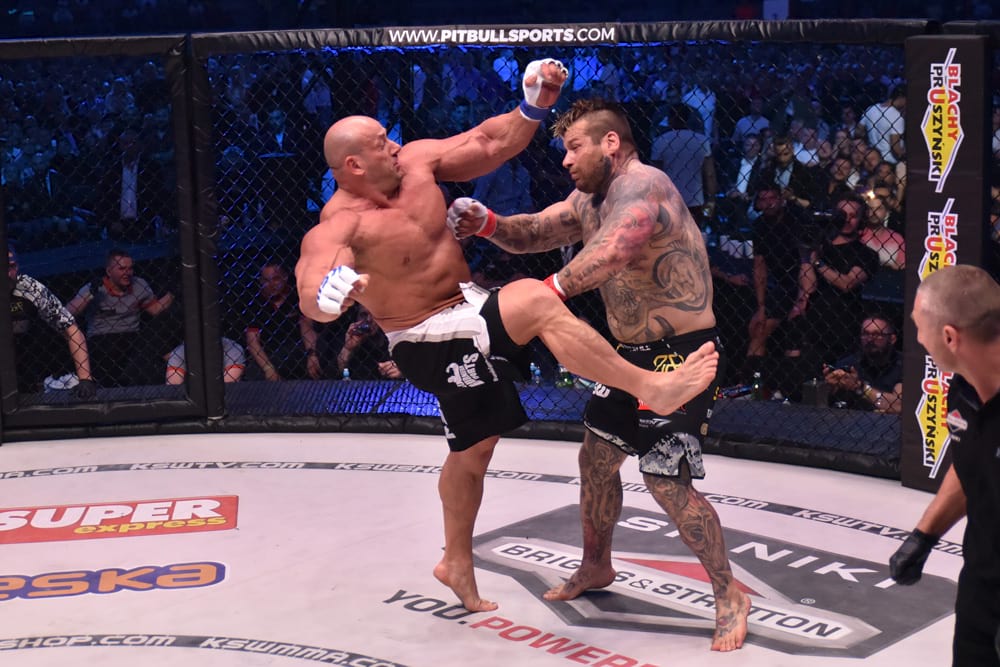
The idea of doing a show at Poland’s national stadium was something Lewandowski and his KSW partner Maciej Kawulski floated for years, but, he admits, was one they initially pooh-poohed. Two years ago, however, they started to get serious and, by December 2016, they’d decided to make their move and give it a go. The reason for this was simple: it could be a case of now or never. Time, after all, stops for no one and Lewandowski and Kawulski were acutely aware and indeed influenced by the knowledge that their key stars, the aforementioned heroes around whom the event would be built, weren’t getting any younger. Pudzianowski, their big name, is now forty. Mamed Khalidov, meanwhile, their middleweight champion and perhaps best fighter, is thirty-six. Alas, should the pipe dream ever become a reality, it had to be now.
“I was hoping for 35,000 tickets sold,” said Lewandowski. “But 58,000 is beyond expectations and I’m glad people realise we go much higher and wider than just MMA fans. We go for all viewers; people who just want to come and see all those magical MMA stars and the show and entertainment we put on. I’m really glad about that.
“Of course there were doubts, though. You never know. No one is confident when they put an event on and try and sell tickets.”
In the weeks preceding the show, Lewandowski revealed to Fighters Only that despite selling 40,000 tickets the show had yet to break even. Venue costs aside, he had booked five KSW title fights – enough, he said, to “build three or four shows” – as well as a champion versus champion match between middleweight king Khalidov and welterweight titleholder Borys Mańkowski. That’s many champions expecting championship purses and nearly as many challengers hoping for just a bit less. That’s the bulk of your outgoings.
One of the challengers, though, Ireland’s Norman Parke, couldn’t have been happier with the deal he struck. Nor could he believe his eyes when about to fight Mateusz Gamrot for the KSW lightweight title. “It was unbelievable,” Parke said. “One of the best nights of my life. There wasn’t a single stress that whole week. Everything was perfect. Once we got to the actual show, we were in a conference room and we could see into the stadium and it was breathtaking, to be honest. I’ve never been in a stadium that big before. I thought, what’s it going to be like walking out here when it’s full of people?”
Parke, a professional fighter for eleven years, had competed all over the world with the UFC; in Brazil, in Boston, in his native Ireland. But never, he said, had he experienced something quite like KSW 39. When stood on a stage being introduced to 58,000 Poles, moments before his title fight, the 30-year-old closed his eyes, opened them again, took a deep breath, remembered as many of his 29 previous fights as he could, told himself it was all priceless experience, and then focused. Really focused.
“I tried my best not to let it overwhelm me but when they said ‘Norman Parke from Bushmills’ and the lights went up it was really hard not to get carried away,” he said. “During my walk to the cage, I saw this light at the far end of the stadium and focused on that the whole time. I didn’t look around and think, wow, look how many people there are here. I just focused on that one spot. I then looked up at another sign when I was in the cage, way up in the sky, and it caught my eye. I used that to focus on and relax me.”
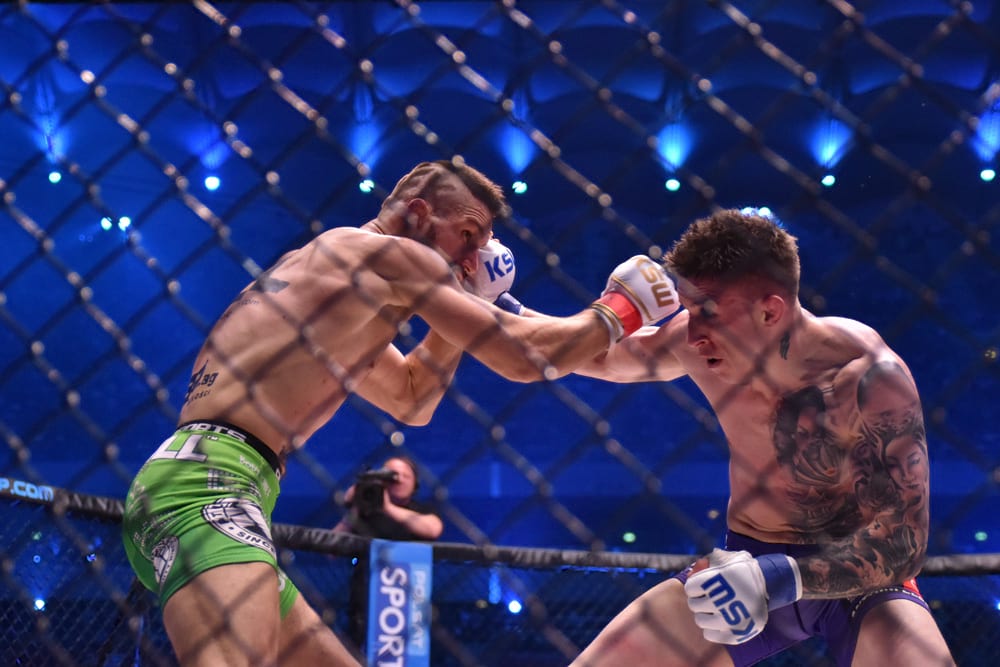
It was at this point KSW commentator ‘Sensei’ Will Vanders implored the audience watching on pay-per-view to “buckle up, funsters” and off they went. All of them, one after another, a production line of professionals and personas; Parke, Gamrot, the other champions, the rapper, the muscle men, the lot. Once it started, there was no stopping it. No lulls in the action, no breaks between fights. If you wanted fights, you’d come to the right place. Some were good, some were not so good, and some triggered only laughter, but they were fights, that’s for sure. Fights with bells and whistles and cuddly toys (Diana Belbita walked to the cage accompanied by a small tiger). Frankly, were it not for the face tattoos and the pale bald heads, both inside the cage and outside the cage, you’d have thought you’d been transplanted back in time and plonked front row at a Pride event.
“Pride hold the attendance record and we’re in second place, but it’s thanks to Pride I got involved in MMA in the first place,” Lewandowski said. “Pride shows were cool. It was about the sport, but not only about the sport. The sport is the most important part, of course, but they also focused on everything around the sport and the fights. I really loved how they celebrated fighters and presented them. We were always looking at Pride, how they do things, how they promote. They were our first idol in MMA. So I’m glad people see some of Pride in our events.”
In many ways, Pride was ahead of its time. Before it was fashionable, they realised the need to promote fights as stories and fighters as personalities in order to capture the imagination of the wider public. Was it as real as it gets? Perhaps not. But Pride, like KSW, had their finger on the pulses of those more excited by the sight of celebrities and human superheroes throwing punches – most of the time badly – than a tactical mixed martial arts match between well-rounded contenders. Even the current pros, those who have donated blood and sweat for years, understand the value in this approach.
“I think it worked really well,” Parke said of KSW’s melting pot of characters. “You had Popek Monster, who was some kind of crazy gangster rapper, and then you had the other guy (Burneika), who was some pro bodybuilder. All he does is lift weights. He doesn’t want to be losing muscle so he’s out the back pumping. We knew it was going to be over quickly with one punch, but the boy got cracked and that was all she wrote. Over in forty-five seconds.
“The game’s changing, man. You get the legit title fights and then you get these freaky fights that keep the casual fans entertained. They know who the freak show people are. They know their background and they know someone is probably going to get f**ked up quickly.”
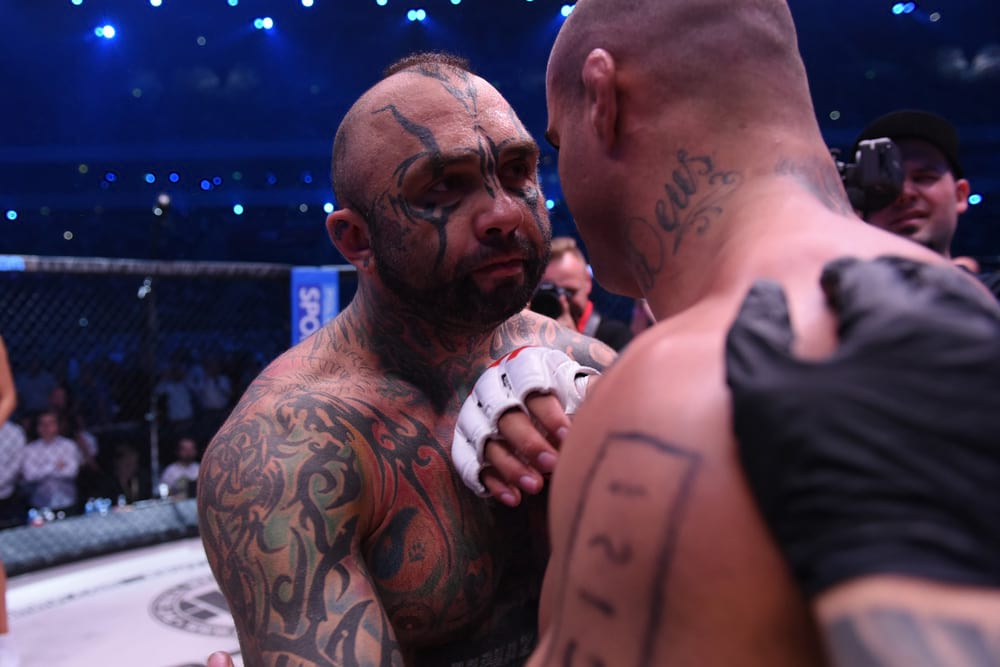
What made KSW’s freak fight offering all the more endearing was its transparency. The freaks themselves never claimed to be anything else and the promoters, too, never attempted to sell their fights as anything other than scraps between larger-than-life famous Eastern Europeans scrapping for reasons beyond climbing rankings and claiming titles. It was this honesty, this discarding of the smoke and mirrors, that set KSW 39 apart. Moreover, the spectacle itself should not be downplayed, nor should the quality of the fights, the real fights, the title fights, all of which provided enough nourishment for the purists to go home happy.
“I feel we’ve done the best show in our history,” said Lewandowski. “Usually I get calls after an event and the people will say it was good and that there were good fights and the entertainment was good. But this time people are calling me and saying the event was amazing and unbelievable. They think they were part of something unique and special. That makes me very, very pleased.
“Sometimes you can concentrate too much on breaking records and worrying about the PR stuff, but during the show it was really magic. I don’t know how else to describe it. It was just magical. It was like all the stars aligned and formed this perfect event.
“The fight between Mamed and Borys and the knockout from Marcin Różalski are moments I’ll never forget. I will remember the entry song of Jurkowski, when the whole stadium was singing, and also how people reacted during the opening ceremony. People had their mobile phones out and the flashes lit up the stadium. That was crazy. All of the fans, from the beginning, were great. They were delighted to be there. The Polish Federation, even though they’re not big fans of MMA, came just to see what it’s all about. For sure, in that moment, we attracted new fans to the sport.”
KSW shot for the stars and the results had to be seen to be believed.
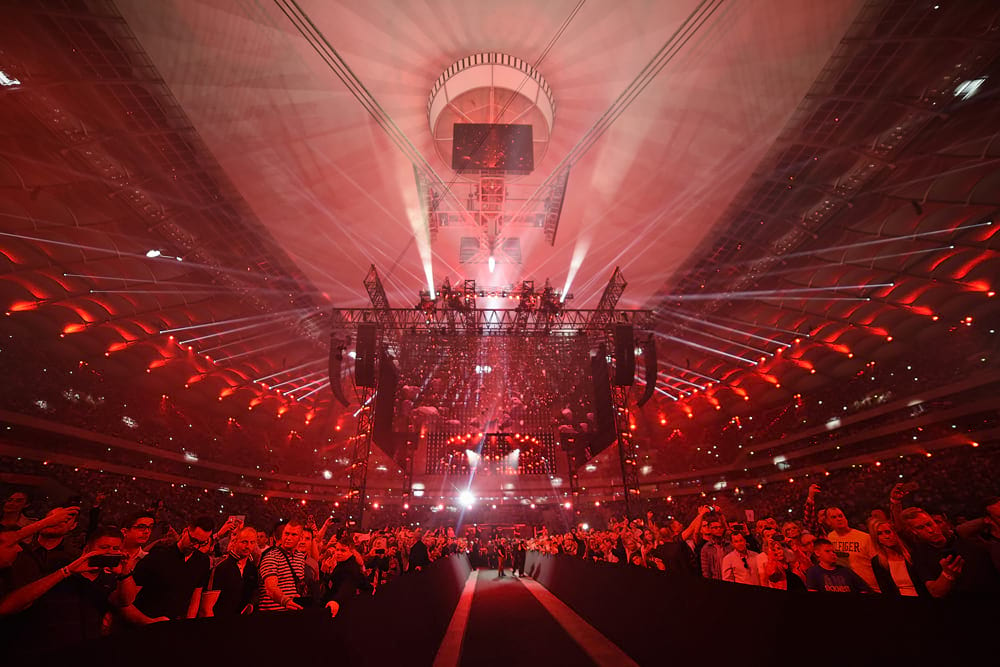
(Images courtesy of Adam Jankowski for KSW)
*** This feature first appeared in the August 2017 issue of Fighters Only magazine ***

